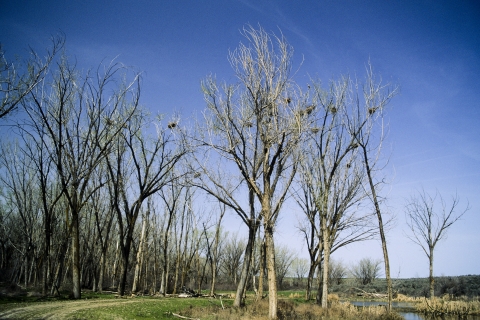About Us
Cold Springs National Wildlife Refuge was one of the first refuges established in the West, created by President Theodore Roosevelt on February 25, 1909. Cold Springs NWR was established primarily to benefit waterfowl and other native birds. However, the 3,102-acre refuge, while small, provides a surprising variety of habitats and abundance of many other wildlife species. The open water on the reservoir attracts large numbers of Canada geese and ducks. Dense riparian riparian
Definition of riparian habitat or riparian areas.
Learn more about riparian areas provide cover for migrating and nesting songbirds. Shrub-steppe areas support coyotes, badgers, ring-necked pheasants, several hawk species and trophy elk and deer, along with dozens of other mammal, reptile and amphibian species.
Overlying a Bureau of Reclamation water storage reservoir, Cold Springs NWR is a blend of open water, managed wetland, riparian, grassland and shrub-steppe habitats. The reservoir itself is notable in that it has three water sources—directly from Cold Springs Creek, from a gravity-fed canal system draining from the Umatilla River and from water pumped through a canal system from the Columbia River, although the latter is used infrequently and only in low-water years in the Umatilla River. What this means to wildlife and recreational users is that the water supply is very consistent and assured.
Located in north-central Oregon approximately six miles northeast of Hermiston, Oregon, Cold Springs NWR is one of the unknown gems of the National Wildlife Refuge System. Although no surveys have been done to determine the exact number of refuge users, or the activities engaged in, anecdotally the FWS knows that use is low and is focused around hunting and fishing, with birdwatching, horseback riding and day-use (e.g., picnicking, social gathering) accounting for additional visitor use days. Most use appears to be from nearby residents, and the refuge is not known to be a ‘destination’ area for visitors from outside the immediate area.
Our Mission
The refuge was established as the “Cold Springs Reservation” on February 25, 1909, through
Executive Order, and subsequently expanded three times through later executive orders. The refuge’s purposes are derived from Executive Orders and the MBCA as follows:
- “as preserves and breeding grounds for native birds”
- “for use as an inviolate sanctuary, or for any other management purpose, for migratory birds.”
Our History
Cold Springs Railroad Station, Cold Springs Wash, Cold Springs Reservoir and Cold Springs Canyon are all well-known geographic names in northwest Umatilla County. Cold Springs Wash, Cold Springs Reservoir and Cold Springs Canyon are all related to the same watercourse, the one that is Cold Springs National Wildlife Refuge. Cold Springs Reservoir was formed when Cold Springs Wash was dammed in 1908 to provide storage for irrigation water coming down the wash and from that diverted from the Umatilla River and, occasionally, from the Columbia River.
Arroyo is a Spanish word meaning 'rivulet' or 'small stream,' and in the western United States the term is frequently used for intermittent creeks or dry watercourses, such as Cold Springs Wash. Doubtlessly inspired by Cold Springs Wash, a post office named Arroyo was established in these parts on July 15, 1878, with Clinton V. B. Reeder as the Postmaster. The name of this post office was changed to Cold Springs on April 2,1880, with Andrew C. Bryan as the postmaster. This post office was short-lived and was closed probably in 1883.
(Above Borrowed from Oregon Place Names by Lewis A. McArthur and revised by Lewis L. McArthur)
Cold Springs National Wildlife Refuge is an "overlay refuge" of the U.S. Bureau of Reclamation's Umatilla Irrigation Project. It was established as the "Cold Springs Reservation" on February 25, 1909, through Executive Order 1032 issued by President Theodore Roosevelt, which reserved the Cold Springs Reservoir (and other national lands) as ". . . preserves and breeding grounds for native birds . . ." to be managed by the Department of Agriculture. It was subsequently enlarged through Executive Order 1439 (November 25, 1911), Executive Order 8380 (March 21, 1940, which also changed the name to its current name) and Executive Order 1083 (March 9, 1955). Public Land Order 1803 (March 4, 1955) further enlarged the refuge.
One final acquisition was authorized, although it did not enlarge the refuge. When the refuge/reservation was first established, a 32.6-acre tract of land thought to be public was included in the boundary and was eventually fenced in. When it was later determined that this tract was privately owned, it was authorized for purchase by the Migratory Bird Conservation Commission under the authority of the Migratory Bird Conservation Act.




